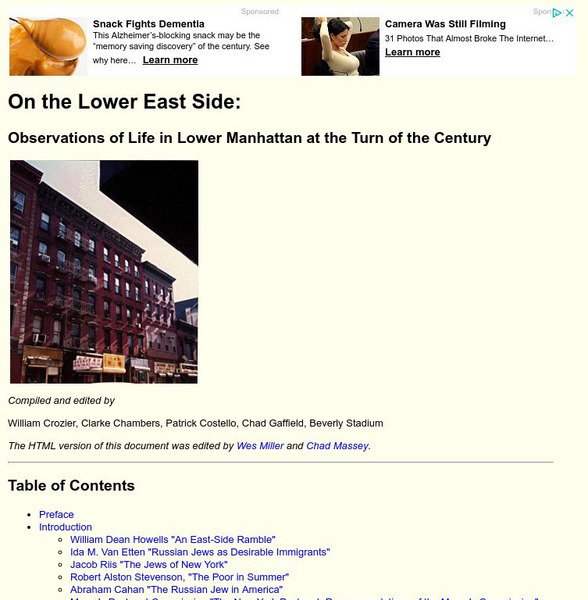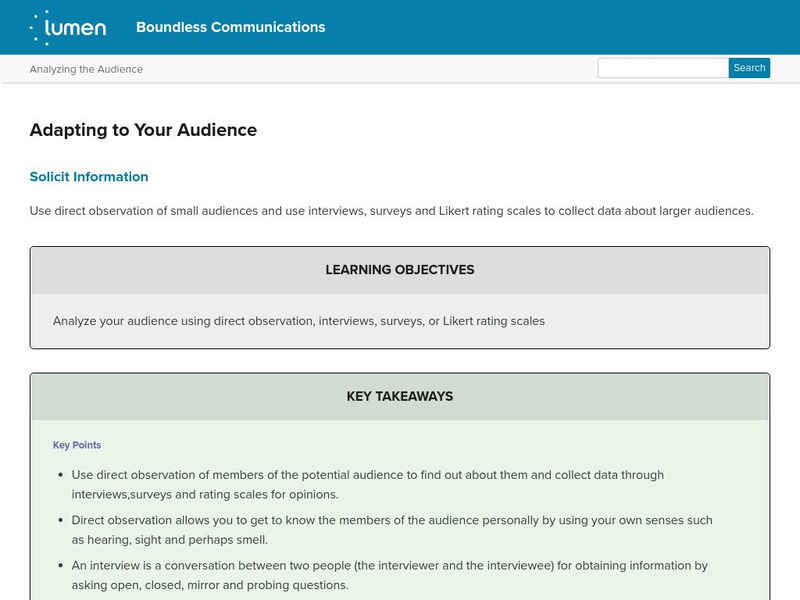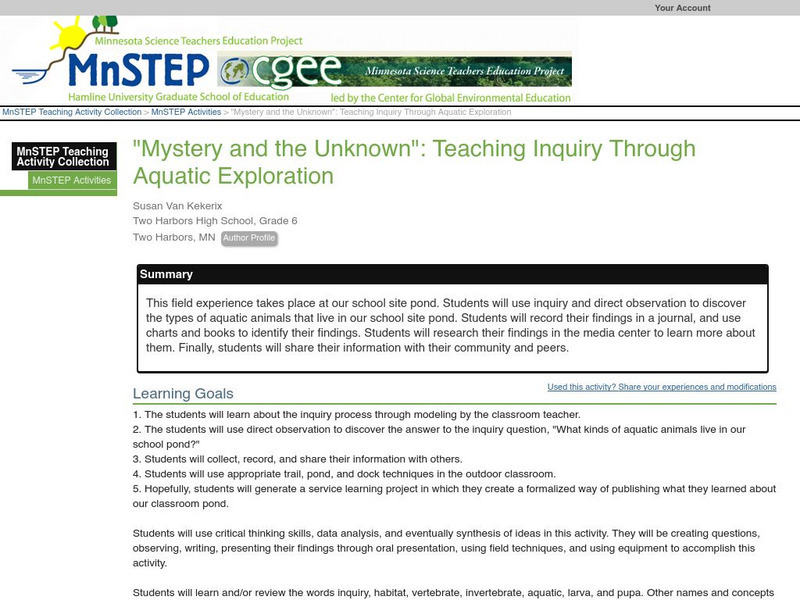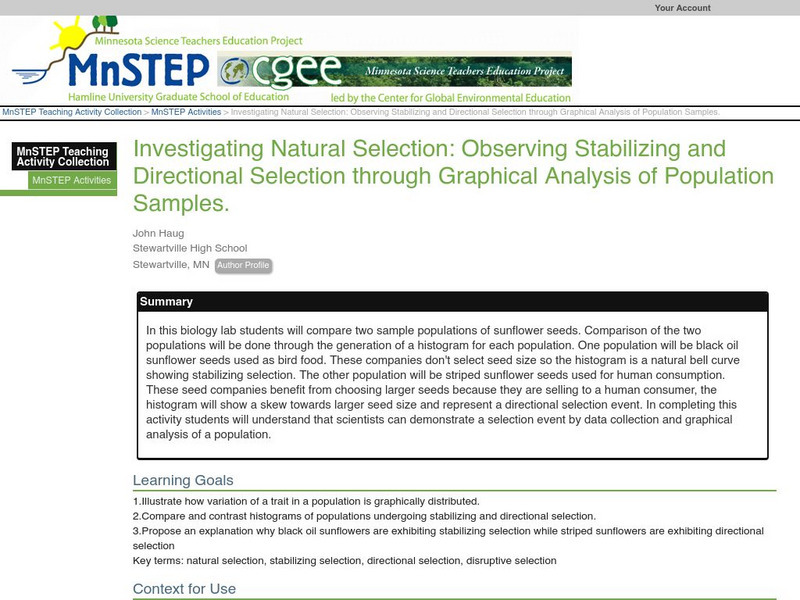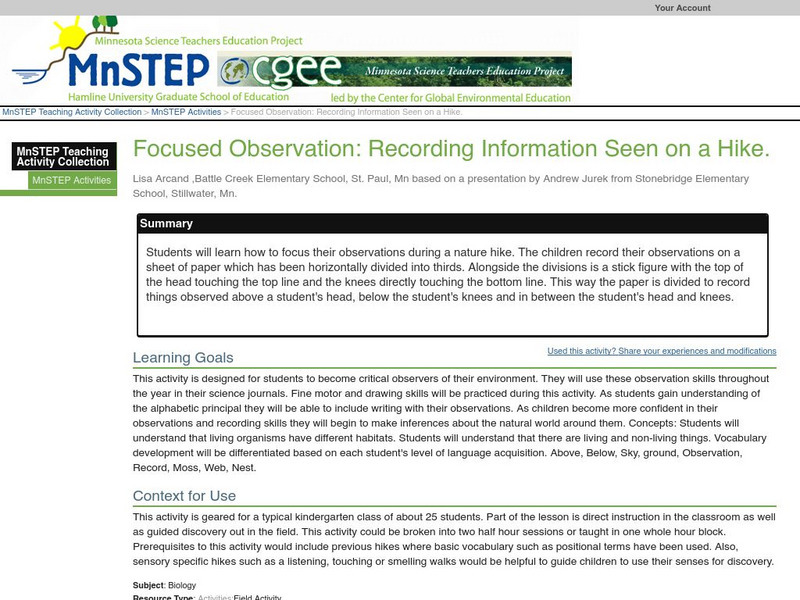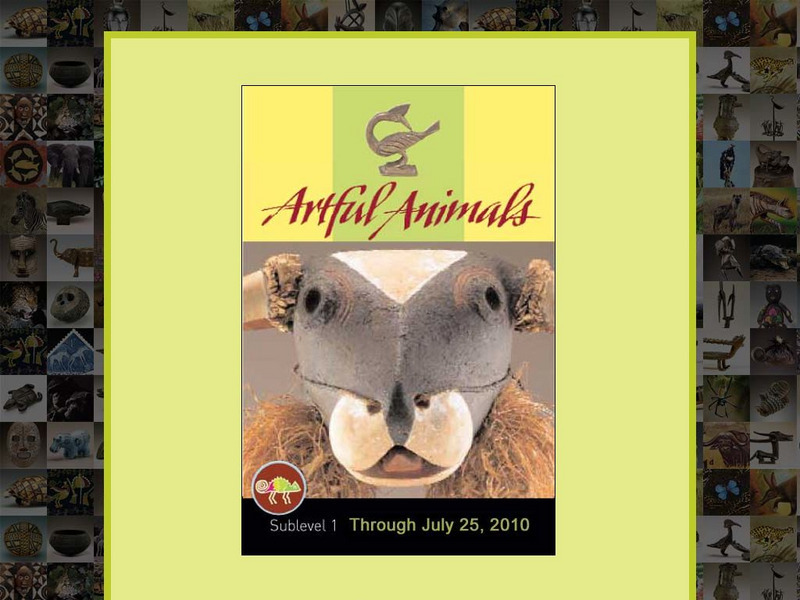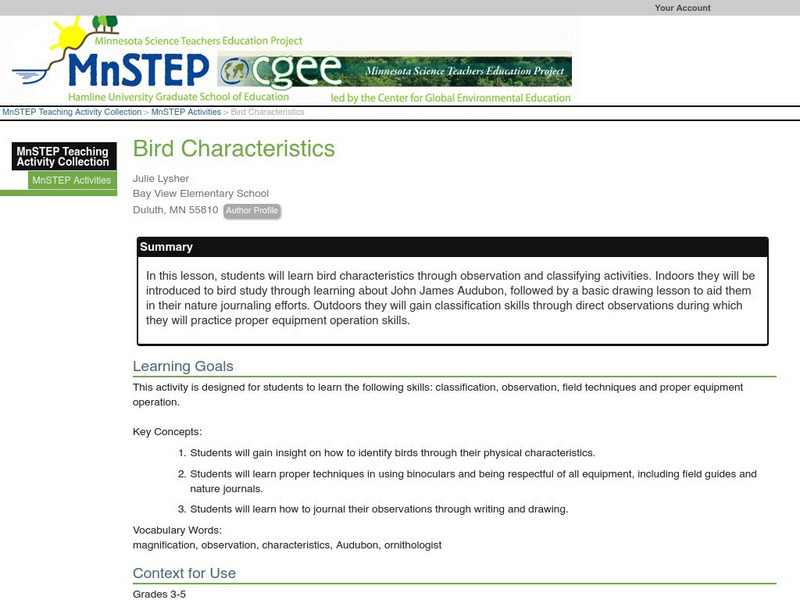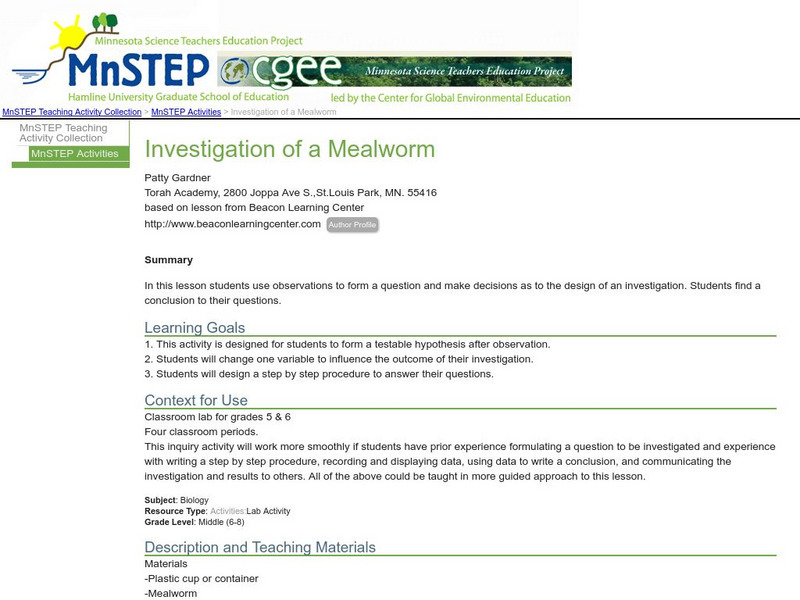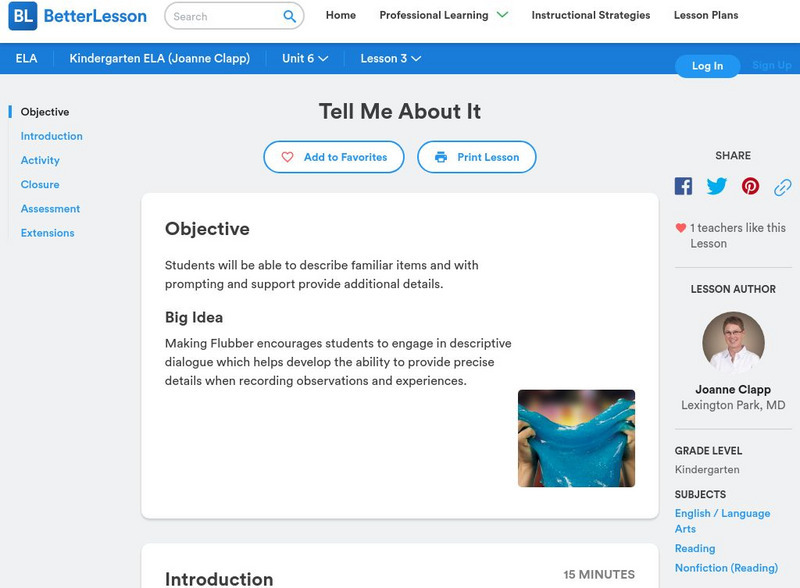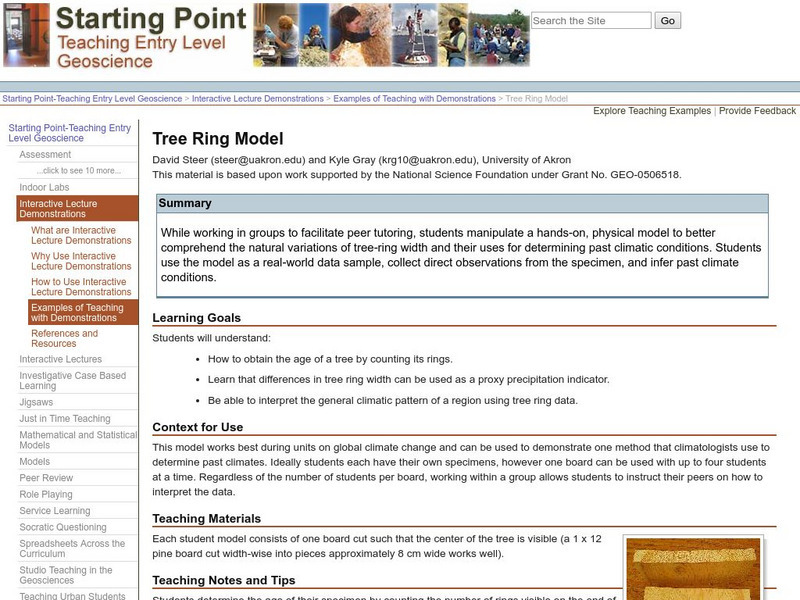PBS
Pbs Learning Media: Observing Refraction of Light
This video segment adapted from Shedding Light on Science illustrates how light changes speed, and thus direction, in a process known as refraction. Includes background reading and discussion questions. [2:05]
Other
On the Lower East Side: Observations of Life in Lower Manhattan
Links to contemporary essays about life on the Lower East Side of New York City in the late 19th and early 20th centuries. These essays cover a range of topics and are well worth exploring to find out what problems writers were exposing...
Lumen Learning
Lumen: Boundless Communications: Adapting to Your Audience
This lesson plan focuses on adapting your speech to your audience including analyzing your audience using direct observation, interviews, surveys, or Likert rating scales and then apply knowledge about the audience to adjust the message...
Science Education Resource Center at Carleton College
Serc: "Mystery and the Unknown": Teaching Inquiry Through Aquatic Exploration
This field experience takes place at our school site pond. Students will use inquiry and direct observation to discover the types of aquatic animals that live in our school site pond. Students will record their findings in a journal, and...
Khan Academy
Khan Academy: Hajj: Islamic Middle East
One of the five pillars of Islam central to Muslim belief, Hajj is the pilgrimage to Mecca that every Muslim must make at least once in their lifetime if they are able; it is the most spiritual event that a Muslim experiences, observing...
Science Education Resource Center at Carleton College
Serc: Investigating Observing Stabilizing and Directional Selection
In this biology lab young scholars will compare two sample populations of sunflower seeds. Comparison of the two populations will be done through the generation of a histogram for each population. One population will be black oil...
Science Education Resource Center at Carleton College
Serc: Focused Observation: Recording Information Seen on a Hike
Young scholars focus their observations during a nature hike by recording their observations on a sheet of paper which has been horizontally divided into thirds. Alongside the divisions is a stick figure with the top of the head touching...
Science Education Resource Center at Carleton College
Serc: Direction of Acceleration
In this short lab, students use Tonka trucks to observe the acceleration of a object as it initiates acceleration, maintains a steady speed, and slows to a stop.
Smithsonian Institution
National Museum of African Art: Artful Animals
African artists commonly base their work on animals observed in their natural habitats. Artful Animals lets you view African art that takes animals as its subject and inspiration. Learn about animals as symbols in African art, the beauty...
Bio Topics
Bio Topics: Direct Observation of Yeast Population Growth
In this classroom lab experiment, students mimic optimal growth conditions for yeast, and with the help of a microscope, observe and record results using a cell counting method.
Other
Center for Science Education: Eye on the Sky: Observing and Using Shadows
This resource provides all the directions and worksheets necessary to make a sundial and record data with it.
Science Education Resource Center at Carleton College
Serc: Bird Characteristics
In this lesson, students will learn bird characteristics through observation and classifying activities. Indoors they will be introduced to bird study through learning about John James Audubon, followed by a basic drawing lesson to aid...
EL Education
El Education: A Field Guide to East Bog Swamp
This micro-field guide was created by 5th and 6th graders in Marlboro, Vermont. Groups of 3 or 4 students worked together to investigate their own 3 by 3 foot research plot, over multiple visits, and then created a field guide to their...
TeachEngineering
Teach Engineering: Android Pendulums
Students investigate the motion of a simple pendulum through direct observation and data collection using Android devices and the AccelDataCapture app.
Science Education Resource Center at Carleton College
Serc: Investigation of a Mealworm
A lab activity where students make observations about mealworms to form questions and decide what direction their investigation will take. While studying mealworms, students will choose a variable to change to observe changes to the...
Better Lesson
Better Lesson: Tell Me About It
Learners will be able to describe familiar items and with prompting and support provide additional details by making Flubber. Making Flubber encourages students to engage in descriptive dialogue which helps develop the ability to provide...
Science Education Resource Center at Carleton College
Serc: Tree Ring Model
In this lesson students will manipulate a hands-on, physical model to better comprehend the natural variations of tree-ring width and their uses for determining past climatic conditions. Students use the model as a real-world data...
CPALMS
Florida State University Cpalms: Florida Students: Evolution: Examining the Evidence
Strengthen understanding of how different types of scientific evidence support the theory of evolution, including direct observation, fossils, DNA, biogeography, and comparative anatomy and embryology.
Khan Academy
Khan Academy: Evidence for Evolution
Explore the evidence for evolution: anatomy, molecular biology, biogeography, fossils, & direct observation.
TED Talks
Ted: Ted Ed: Could We Create Dark Matter?
We don't know what dark matter is made of, and we've yet to directly observe it, but scientists theorize that we may actually be able to create it in the Large Hadron Collider, the most powerful particle collider in the world. CERN...
NASA
Nasa Space Place: Dark Matter
Offers an explanation of dark matter and dark energy, material that scientists cannot directly observe.
PBS
Pbs Teachers: Runaway Universe
Use this activity to model how scientists use indirect observations to define problems that are not directly measurable.
Science Education Resource Center at Carleton College
Serc: Bubbling Blobs
In this chemistry lab, students investigate how oil and water don't mix. They will work on their observation skills and their ability to follow directions to ensure they get the correct results. Students can then develop a new, testable...
PBS
Pbs Learning Media: Math + Arts: Geometry in Dance
In this lesson, learners observe symmetry, geometric shapes, and angles in two Early American dances, and then choreograph their own dance with symmetrical figures. Media and teaching materials are included.
Other popular searches
- Euglena Direct Observation
- Eugenia Direct Observation
- Euglenda Direct Observation
- Glenda Direct Observation
- What Is Direct Observation

